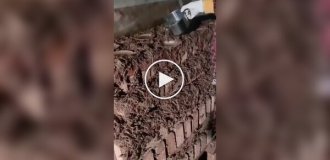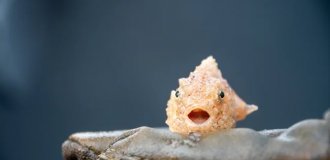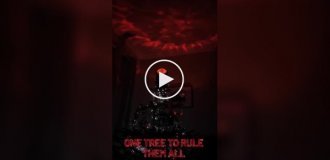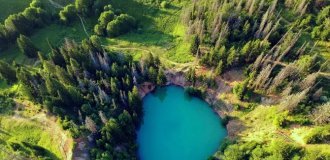Termites are a threat to wooden buildings and a real threat to human life. Mighty trees struck by these insects crumble before our eyes with one small shock. The same can be said about wooden buildings. Many films and scientific television programs have been made about these insects.

Termites (lat. Isoptera) (eng. Termites, White Ants)
Special services are being created to combat them. They are poisoned with the most powerful poisons. But the results of these activities are hardly noticeable. Termites have both brought and continue to bring enormous problems to humanity. But is there really only harm and no benefit from them? Now we'll find out.
Termites, like ants, are social insects. They are also called “white ants”, but in fact they are far from related. Termites trace their ancestry back to cockroaches.

Habitat
There are about 2,800 species of termites in the world, and most of them are indigenous to the tropics and subtropics. We have only 2 species in Russia - in the Sochi and Vladivostok areas. But with the development of cities and powerful heating systems, roads to the north opened for termites. They wait out the winter in heated buildings, and when it gets warmer, they move on. Termites have now been spotted even in Hamburg, a city located far from the warmest part of Germany.

Termite habitats
Social structure
In a huge multimillion-dollar termite colony, all its inhabitants are clearly divided into castes: mature individuals (including the “queen” and “king”), soldiers and workers.

The smallest of them are worker termites. Their body length does not exceed 1 cm (0.5-0.8 cm). Due to their constant residence in shelters saturated with water vapor, they have a soft and light body. And due to the underground way of life, the eyes are either very poorly developed or absent altogether. Working individuals are easily recognized by their rounded heads and underdeveloped chest. But this does not apply to all species; in South African Hodotermes termites, working individuals often crawl to the surface, therefore they are colored dark brown.

Working termite

Unlike ants, among the workers there are both males and females (ants have only females). Their main purpose: caring for offspring, obtaining and storing food, building and repairing a termite mound. In addition, they feed soldiers who, due to the special structure of the head capsule, cannot feed themselves.

Dark South African worker termites Hodotermes

The next caste is soldiers. These are also working termites, but they have different functions and, as a result, a different structure. Their main goal is to protect the colony from attacks by ants and other enemies. Powerful and long mandibles (jaws) serve as weapons of defense.

Soldiers

In some tropical species, a small process on the head is added to the mandibles, through which the soldier termite sprays a special sticky secretion at the enemy, which dries on contact with air and impedes movement.

Rhinoceros termites (with a growth on the head)

Soldiers have a large head capsule. And there are reasons for this. In addition to the fact that it has powerful jaws, it also acts as a kind of plug during the blockade of narrow tunnels.

When the termite mound is partially destroyed, hordes of soldiers come to the defense. They try to hold off the enemy's advance until the worker termites close the gap. But in this case, they themselves remain trapped, since there is no turning back for them.

And finally, the top, the caste of sexually mature individuals. It consists of a queen (the egg-laying female), a king (the male that fertilizes her) and other reproductive individuals.

King
The size of the queen is simply enormous compared to other termites. It can reach a length of 10 centimeters. The body, in particular, the abdomen of the female, after the start of reproduction, increases hundreds of times. Because of this, she can no longer move and feed on her own. All these worries fall on the fragile shoulders of working termites. If necessary, they will carry her and feed her.

Queen
[img]https
//cn12.nevsedoma.com.ua/photo/87/7/17000007.jpg[/img]
Next to the queen throughout her life is the king, who is only slightly larger than the size of an ordinary termite soldier. Only he has the right to mate with the female. Unlike ants, the male does not die after fertilization.

Flying mature termites
The female's fertility is amazing. She can lay about 1700-3000 eggs per day. All this time, she secretes special mucus on her abdomen containing pheromones. Worker termites happily lick it off.

Young sexually mature individuals live in the termite mound of their “parents” until a certain time. But with the onset of the swarming period (spring-early summer), they all leave their “father’s house” together and begin to mate. At this time, they become very vulnerable, since immediately after fertilization, both the female and the male gnaw off their wings. Many of them become easy prey for insectivorous birds, spiders, millipedes and other large insects. Those who are lucky begin to create a nest.


But not everyone leaves the termite mound; several pairs still remain. This is necessary in case the main female or male dies, but this happens very rarely.

Fallen termite wing

Lifestyle
The number of termite colonies can reach several tens and even hundreds of millions of individuals. And they all need a home, which is a nest - a termite mound. Its approximate location is determined by a pair of sexually mature individuals that left the “parental home.” After the birth of the required number of working individuals, they begin to create a reliable shelter for the entire future colony.

Each type of termite has its own nests, most of which consist of 2 parts: above ground (in the form of a large elevation) and underground (representing a network of numerous tunnels and rooms). The main building material is a mixture of excrement of working termites, clay (in hot tropical countries) or crushed wood and saliva. This combination allows you to create very strong shelters that are very difficult to break. In addition, their walls are waterproof.

The size of some termite mounds is amazing. The height of their ground part can reach 8 meters! The record was recorded in Zaire. There the height of the termite mound was 12.8 meters. In the shadow of such giants, buffalos and other large animals, such as elephants, find refuge from the scorching sun. This part of the termite mound most often contains chambers with eggs, larvae and “mushroom gardens”, as well as an extensive network of ventilation tunnels.

There you can also find small “farms” that house animals that carry out various symbioses with termites. Scientifically, these animals are called termitophiles. Their role can be played by various insects, for example, the termitoxenia fly. They secrete special substances for termites, which they lick with great pleasure, and termitophiles, in turn, receive a favorable microclimate and a rich source of food.

In the tropics, where there is high humidity and it often rains, termite mounds are located not underground, but on trees. In arid places, for example, in Central Asia, the Trans-Caspian termite creates nests that go to a depth of 12 meters, while on the surface there is no sign of a termite mound in this place.

Termite mound on a tree

Nutrition
Termites feed on plant foods, in particular dry wood. They are helped to digest such heavy food by the simplest organisms living in their intestines - flagellates. Up to 200 species of protozoa can be found in the stomach and intestines of each termite. Sometimes their mass is about 1/3 of the total mass of the insect. Flagellates process inedible wood into sugars, which are easily digestible.

We have already mentioned that only working individuals can feed on their own. In turn, they feed everyone else: the soldiers, the king and queen, and the larvae. Soldiers feed on their mouth secretions or excrement, which is still rich in nutrients. “Reigning individuals” also feed on the oral secretions of workers and larvae. They feed the larvae with spores of moldy fungi or salivary secretions.
[img]https://cn12.nevsedoma.com.ua/photo/87/7/31000
004.jpg[/img]
Termite work
In addition to wood, they will happily gnaw on rotting wood, animal skin, leaves, manure and other animal and plant debris.

Benefit or harm?
In nature, termites function as recyclers of plant residues. They also play an important role in the formation and mixing of soil layers. Few other animals are capable of performing such functions, especially in the tropics. To restore justice, it must be said that these insects feed on dead wood and only in extreme cases attack healthy trees.

But when a person encounters termites, war cannot be avoided. In tropical countries, these insects are dangerous pests that destroy wooden buildings. There are known cases of collapse of houses attacked by termites. They chew out all wooden floors, furniture, in general, everything that is made of wood. They won't give up books either. For example, in South America it is now difficult to find a book that is more than 50 years old. In Southeast Asian countries, sometimes small towns and cities had to be relocated due to termite infestations.

Tree affected by termites
Spotting a termite attack is not easy. The fact is that they gnaw only the internal contents, leaving the outer shell intact. They can handle not only wood, but even metal. Here's an example. Not long ago, the news reported that in one of the Indian banks, termites managed to get into one of the bank's safe deposit boxes and chew up a decent amount of money and securities.

This is not an isolated incident. A similar thing happened in 2008, when a certain Dwarik Prasad discovered only dust from money and securities in his safe deposit box.
How is this possible? Most likely, we will find the answer to this question in a short excerpt from Nikolai Kozlov’s book “The Life of Termites”: “...They drill through the wax and tin caps that crown the bottles to get to the corks. They approach the tin of cans scientifically: first they erase the layer of tin covering it, then they smear the exposed tin with a special juice, which makes it rust, after which they can easily drill through it...”
To combat termites, special services have been created; they are poisoned with the strongest poisons. In a word, a real war is being waged with them, but it remains to be seen who will emerge victorious.






















